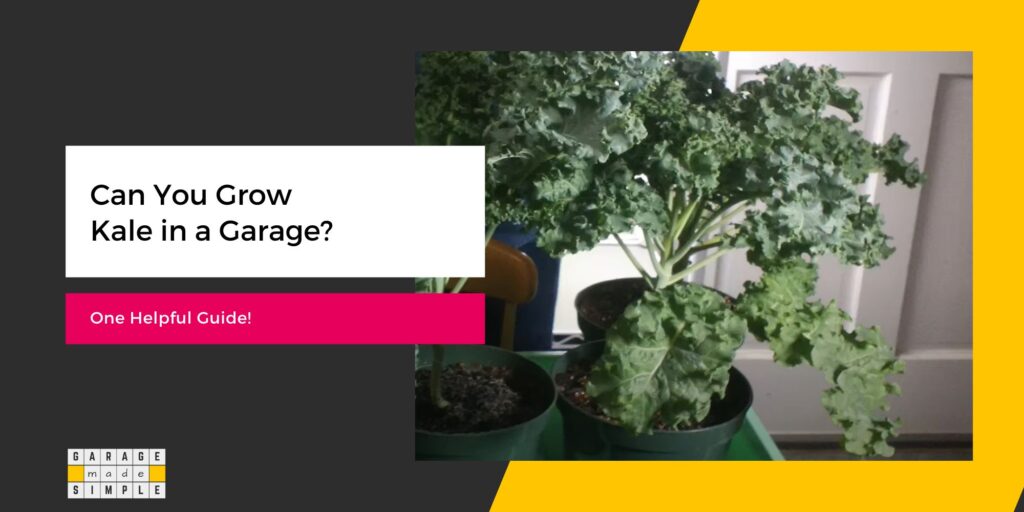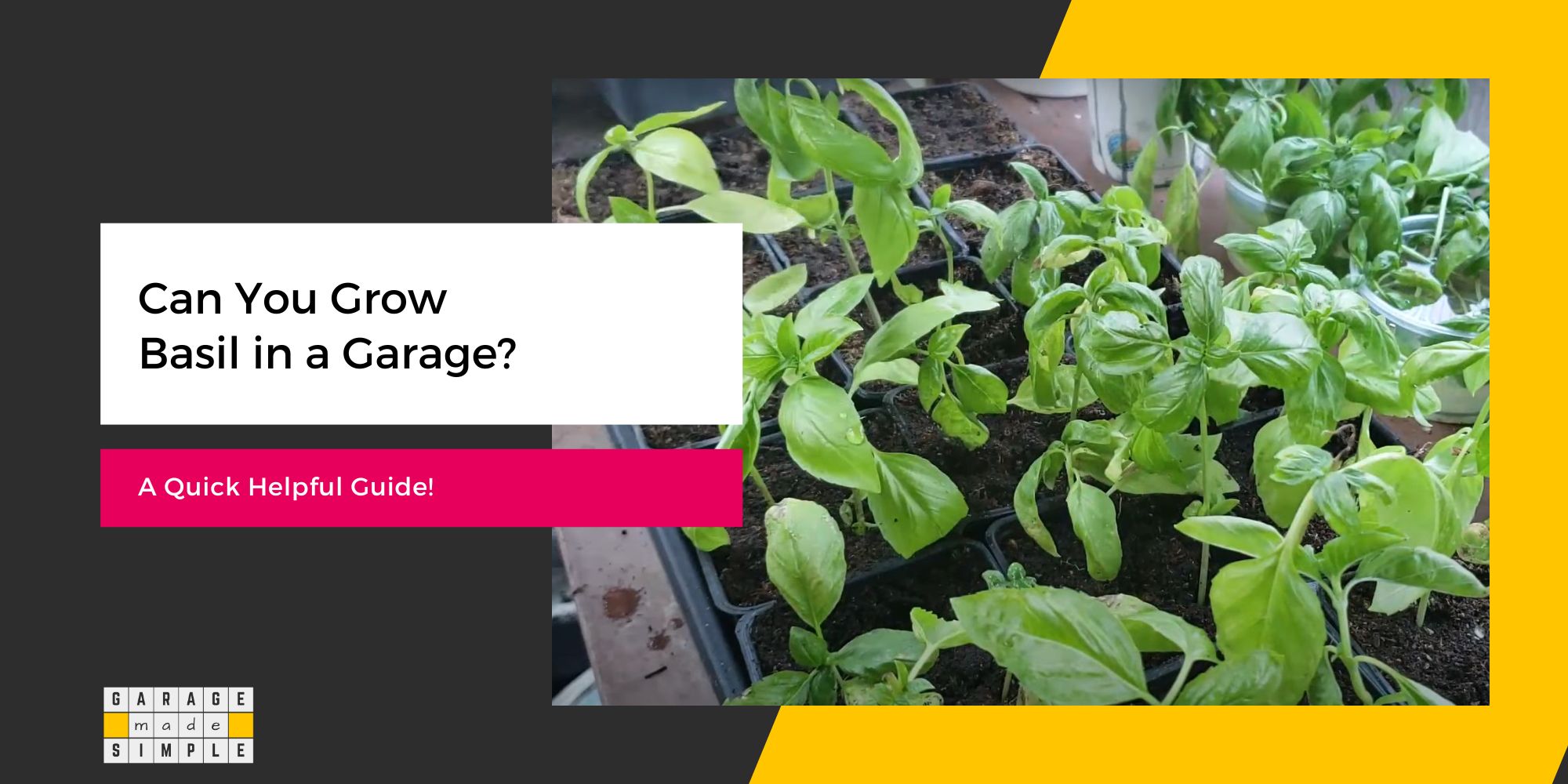Can You Grow Kale in a Garage? (One Helpful Guide!)
garagemadesimple.com is a participant in the Amazon Services LLC Associates Program, an affiliate advertising program designed to provide a means for sites to earn advertising fees by advertising and linking to Amazon.com . The website is also an affiliate of a few other brands.
Can You Grow Kale in a Garage?
Kale is a superfood. It is packed with nutrients, vitamins and antioxidants. Tender leaves from a young plant are delicious when used in salads. As the plant matures you could make tasty side dishes by sauteing the leaves. But can you grow kale indoors, in your garage, for example?
You can grow kale in pots in your garage, without too much effort. Alternatively, you can also grow kale indoors using a garage hydroponic system. Harvest baby kale to be eaten raw and the mature plant for cooking.
Most kale varieties are biennial. You can harvest it continuously throughout its first year. Just keep sniping off the outer leaves and the plant will grow new inner leaves.
In its second year the plant will go into reproduction and seeding stage. The leaves do become tougher and acquire a sharper taste but are still great for cooking.

How to Grow Kale from Seeds in a Garage?
Get Seedling Starter Trays
You need to start by planting the kale seeds in seedling containers. You can order them online from Amazon. They are not too expensive and are super convenient.
Alternatively you can reuse some waste household items such as egg shells placed in egg cartons.
Buy Seed Starting Potting Mix
Buy a good quality seed starting mix such as Miracle-Gro Seed Starting Potting Mix. Open the pouch and pour the mix in a large plastic tub or bucket. Add water and knead with your hands or mix with a trowel.
Keep adding water and kneading (troweling) till all the water is completely absorbed. Make sure that the seed starting mix is moist but not wet or soggy. Fill up the seedling containers.
Seed Germination Process
Kale seeds typically germinate in 5 – 7 days. Place the seedling trays on shelves in an area of the garage which is warm.
At this stage the seeds do not need light. They just need moist warmth to germinate. Make sure to mist the seedling trays every day to ensure the soil is always moist.
The first two leaves (aka cotyledons) are not real kale leaves. Once the kale seeds have germinated they need an exposure of 6 hours of natural sunlight or T5 Fluorescent grow lights each day.
The next 2 – 4 leaves are the real leaves. They appear in around 2 weeks. It is now time to transplant the seedlings to their individual pots or containers.
Use Large Containers
Many varieties of Kale will grow to be 1’ – 2’ tall on maturity. Some can even grow up to 3’. The roots need to grow deep and the soil in the pot must have enough nutrients for growth.
A 5 gallon bucket is usually 12” – 15” tall and has a 10” – 12” diameter. It is a good size for a single kale plant grown in the garage. It is a good idea to keep these buckets on a 3 tier shelf with wheels, such as, Finnhomy 3 Tier Heavy Duty Commercial Grade Utility Cart, so that you can move them around if required.
Do remember to drill a few holes in the bottom of the bucket for drainage!
Kale Needs Light
The challenge of growing kale in a garage is arranging for adequate sunlight. Kale needs a minimum of six hours of direct sunlight each day. It will grow in partial shade but the leaves may not be as stocky.
The alternative is to arrange to grow them under T5 Fluorescent grow lights such as HYDRO PLANET T5 Grow Lights. Choose the size that works for your set up.
Use a mix of cool white and warm white fluorescent tubes to mimic natural sunlight. Keep the lights at least 6” above the kale and turn them on for 4 – 6 hours a day.
Providing Sufficient Nutrition
In addition to light and water the kale plant needs sufficient nutrition in the form of correctly formulated fertilizer. A balanced all purpose fertilizer works fine for kale plants. Apply the fertilizer on the potting mix in the container every 7 – 14 days.
I recommend using a general purpose nutrient such as Miracle-Gro Water Soluble All Purpose Plant Food.
Harvest Kale The Right Way
As the kale plant starts to grow you need to prune the lower, outer leaves. This will ensure the plant will grow healthy and can be harvested for a longer period of time.
Depending on the variety, kale is ready for harvesting within 55 to 70 days of planting the seeds. It is important that you harvest by snipping off the lower, outer leaves at the end of their stems. Do this frequently so that the upper, inner leaves can grow.
If you follow this harvesting procedure, you can harvest from a kale plant for at least a year, probably longer.
How to Grow Kale in a Garage Hydroponic System
The procedure to grow kale in a garage hydroponic system is quite similar to growing it in soil or potting mix. The main difference is that the soil or potting mix is replaced by a nutrient rich solution.
Seed Germination
Take 2” cubes of rockwool and soak them in a water tray till they are completely wet. Rockwall. Use a toothpick to pierce a hole in the center of the cube. Insert a couple of kale seeds in the hole using the toothpick.
Leave the cubes in the tray of water, cover them loosely with a lid to keep the moisture in. Put the tray away in a warm section of the garage. The kale seeds do not need light at this stage and will germinate in 5 to 8 days.
Transplantation
Expect the kale seedlings to sprout in around 2. You will see 2 to 4 regular leaves in addition to the 2 cotyledons. You will also notice roots jutting out from the bottom of the rockwool cube.
Now it is time to transplant. The seedlings need light, space and nutrients to grow and mature. Place the rockwool cubes in 2” net pots. The net pots can then be placed in the garage hydroponic system.
Best Hydroponic System for Kale
The Deep Water Culture (DWC) hydroponic system is the most suitable for growing larger kale plants in the garage. It can accommodate the deep growing roots and better support the taller plants.

A relatively new hydroponic system, “The Kratky Method” is also getting quite popular for growing kale in a garage. It is a passive hydroponic system and no electricity is required.
Bottom Line
The bottom line is that you should certainly include kale in your list of vegetables to grow in the garage. Growing kale indoors is an engaging and rewarding hobby. The bonus is a regular supply of a super food rich in antioxidants.
If you are short on space and time then using hydroponics in your garage is a great alternative!
Thank you very much for reading the post. I do hope you found it informative and useful.






